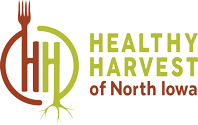The City of Charles City, Iowa Department of Agriculture and Land Stewardship and the Clark Street Garden Corridor Committee will be hosting a ribbon cutting of their collaborative Edible Arboretum project on Clark Street, 2nd Avenue and B Street at 1 p.m this Friday, May 31st in Charles City. Please join us to help celebrate this collaborative approach to community-based, perennial local food place making and urban water quality design features.
The Clark Street Garden Corridor’s Edible Arboretum project began in 2017 with the help of a grant from the North Iowa Local Food Coalition to hire an Iowa State University Local Food Coordinator and the ISU Design Lab to facilitate community input for a local food project in Charles City. What came out of the listening sessions was a roadmap to an urban perennial food forest or what is now called an edible arboretum. The perennial landscape was designed to include several varieties of native nut and fruit bearing trees and shrubs that community members could pick when ripe and learn more about perennial foods. The trees and shrubs were planted in 2018 by volunteers who helped facilitate the adjacent Clark Street Community Gardens and Clark Street Pollinator Habitat. Local community members donated a portion of the trees and shrubs by “adopting” them to assist with their care for the first few years of growth. The walkway was one of the final pieces of the arboretum that required funding. In 2022, the former Charles City Cedar River watershed coordinator was seeking an urban water quality design project. A committee consisting of the Charles City Watershed Coordinator, Charles City City Administrator, Charles City Parks and Rec Director, the Charles City City Engineer and the chair of the Clark Street Garden Corridor Committee applied for a matching IDALS Iowa Partners in Conservation grant. The City of Charles City leveraged an Iowa DNR State Revolving Fund (SRF) Sponsored Project Dollars grant and the project was granted to fund and showcase various urban infiltration-based water management hardscapes and other water quality design elements that community members could then use and implement on their own properties. Some of these elements include: a bioretention cell, grassed pavers, permeable pavers, rain gardens, native turf, and pollinator habitats.
The location of the Edible Arboretum was formerly neighborhood homes destroyed in a major flood in 2008.
We look forward to your visit of Charles City and the Edible Arboretum!
Photo Copyright: CHARLES CITY PRESS





